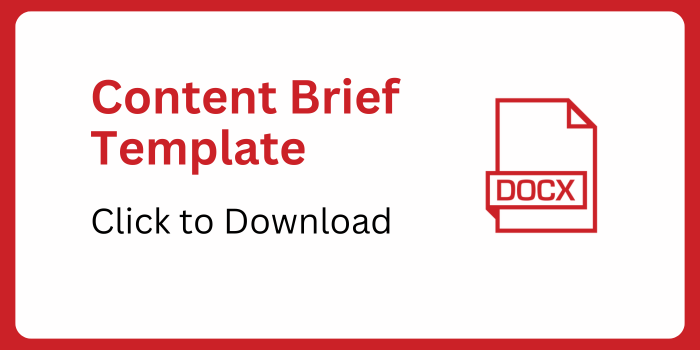
Content marketing is one of the pillars of search engine marketing. However, producing content on a regular basis takes proper planning and management.
Since agencies with multiple clients tend to have to produce content at scale, they need some way to effectively manage their content production efforts, especially when outsourcing to writers.
Cue the content brief.
Agencies use content briefs to keep in-house and outsourced writers on the right track and to optimize their content production efforts for their clients.
In this article, you will learn how to create the perfect content brief for writers. We’ll also share a downloadable content brief template that you can use in your agency.
As a tool used by hundreds of digital agencies, we here at SEOptimer have built relationships with agencies from all over the world.
As such, we’ve asked some agency founders and executives to share insights on how they structure their content briefs so that their writers can deliver outstanding content according to the client’s exact specifications.
Our Experts
We’d like to thank the following founders and agencies who so generously gave up some of their time to share their insights:
- Matt Diggity @ Diggity Marketing
- Michael Maximoff @ Belkins
- Kevin Hall @ Webserv
- Milosz Krasinski @ Chilli Fruit Web Consulting
What is a Content Brief?
A content brief is a document that gives writers clear instructions and guidance on how to create a piece of content.
Irrespective of the deliverable, whether for a regular blog post, pillar post, ebook, or downloadable guide, most content briefs contain more or less the same elements.
The most common parts of a content brief include the word count or length, the target keyword(s), the topic and title, and an outline of what the end product should look like. We’ll discuss all of the important elements of a content brief at a later stage in this article.
You should also take note, that a meeting with a writer does not qualify as a content brief. Sure, you can still have a meeting with your writer to go over some important discussion points or to address any questions he/she might have.
However, a very important characteristic of a content brief is that is documented and in writing. The reason for this is so that there is no ambiguity on what’s expected of the writer.
Content Brief Example
Before we dive into the elements of SEO content briefs, you’ll see an example of a brief that we created for one of our top-performing blog articles:
Title
Benchmark Your SEO in 5 Easy Steps + Essential Metrics to Measure
Length in Words
1500
URL: /benchmark-your-seo
Notes & Guide
Intro
- What is SEO benchmarking?
Main content
- Why is it important to benchmark your SEO
- How to benchmark your SEO
- Determine which metrics to benchmark
- Do an analysis of the respective metrics
- Compare technical differences between you & your competitors
- Determine which areas you need to improve on
- Regularly monitor progress
- SEO metrics you need to understand & compare
- Organic traffic
- Landing page conversions
- Backlinks
- Number of keywords you are ranking for vs competitors
- Bounce rate
- Dwell time
- SEO benchmark tool (Add section on how SEOptimer can help website owners keep track of SERP performance)
Conclusion
Competitor and Reference Articles
- https://www.brightedge.com/blog/6-seo-benchmarks-you-cant-afford-to-miss
- https://monitorbacklinks.com/blog/seo/seo-benchmarks
- https://www.smartbugmedia.com/blog/5-seo-benchmarks-to-track-in-2020
- https://www.contentmarketingspot.com/search-engine-optimization/how-to-measure-seo-performance/
Keywords we’re targeting (that you should try to include)
| Keyword | Monthly Search Volume | Keyword Difficulty |
| benchmark your seo | 500 | 6 |
| seo benchmark tool | 60 | 19 |
| benchmark seo | 40 | 5 |
| seo benchmarking | 30 | 7 |
SEO Content Brief Template
There’s no formal layout or blueprint for creating a content brief for your team of writers. As such, the template that you can download here is customizable according to your own needs and requirements.
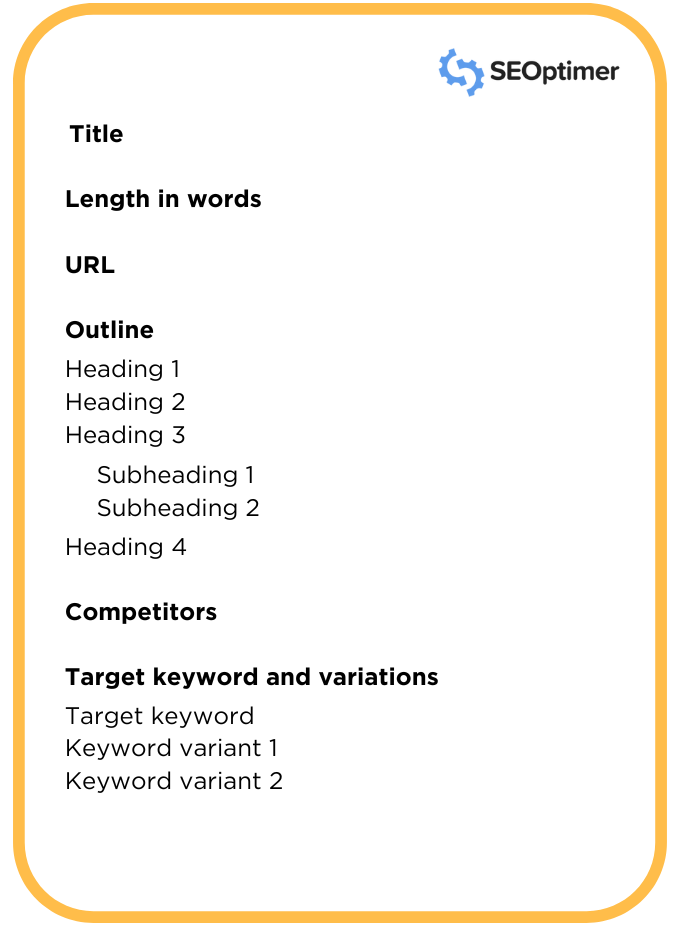
This content brief template is the exact one that we give to all our in-house and outsourced writers when producing content.
Elements of an SEO Content Brief
To produce content that maintains a high standard you will need to standardize your briefs.
Luckily, content briefs can be used for a variety of content formats, even video content for YouTube, so you won’t have to change too many of the elements when creating briefs for different content types.
Title
The intended title of the blog article or ebook will give the writer more context and information about what the end product must look like.
If you’ve got multiple title ideas for a piece, but haven’t settled on one yet, include all the variations in the content brief. Just as long as all the titles describe the same “big picture” idea to avoid any confusion.
Length
It’s essential that you include the target length, or word count, of the article in the content brief. This is so that you can manage how much you’re going to pay for the blog article as well as have the best possible chance of it obtaining a high search engine ranking.
Imagine, you paid your freelance writer per word, and you omit the word count in the brief. The writer might end up writing a 4,000-word guide on the intended topic, whereas you only had the budget for a 2,000-word article.
By including the intended length, the writer knows exactly how many words she has available to thoroughly and accurately discuss the topic at hand.
Content length also plays an important role in a blog article’s ability to achieve a high search engine ranking.
Data from Backlinko show that the average word count for the top 10 results in Google is around 1,400 words.
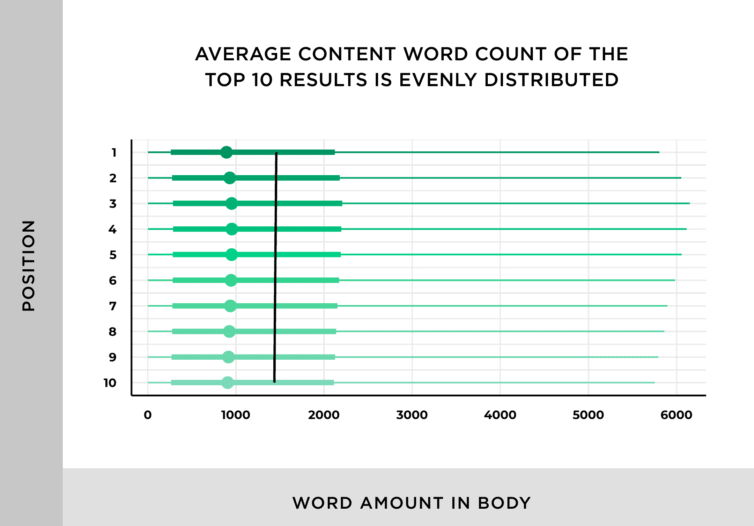
Now, this doesn’t necessarily mean all the content that you get produced should be 1,400 words in length.
Each industry and topic is unique, that’s why you need to do a SERP analysis to get the average word count of the top-ranking results.
As a general rule of thumb, we like to set the target word count to just a few hundred words more than the average word count of the top 10 ranking articles.
Objective
The writer needs to know the objective of the work that she needs to produce. For instance, there’s a difference between a product page versus an informational blog post.
Likewise, there’s a difference between a transactional post and an informational one. A transactional article will likely focus more on benefits and features, whereas an information-based piece will likely aim to educate or teach readers.
Determining the objective of a written piece of content will depend on the predetermined content marketing plan that you’ve discussed with the client during the onboarding process.
Now, it isn’t necessary to include the objective of an article in the content brief if you’ve discussed what type of content you need to be produced beforehand.
For instance, we’ve communicated with our outsourced writer(s) that they should only produce informational content for our blog at the start of our working relationship.
If we need to get promotional content produced, we’ll just simply add that to the brief, and highlight it so that it stands out.
Target Keyword
Your content production workstream is likely aimed at helping your clients improve their search engine rankings for a particular search query or set of queries.
With that being said, it’s vital that you include the target keyword and two to three variations of the keyword in the content brief.
In addition to the article objective, almost all writers use the target keyword as the starting point of a new article.
By highlighting the main keyword for a piece, the writer will know which keyword variant to prefer above others.
However, you should also include variations of this keyword so that the writer can mix it up a little and it also helps the content rank for various long-form, alternative keywords.
To obtain these keyword variations, it’s best to use a keyword research tool to find the ones with the lowest competition and the highest search volume.
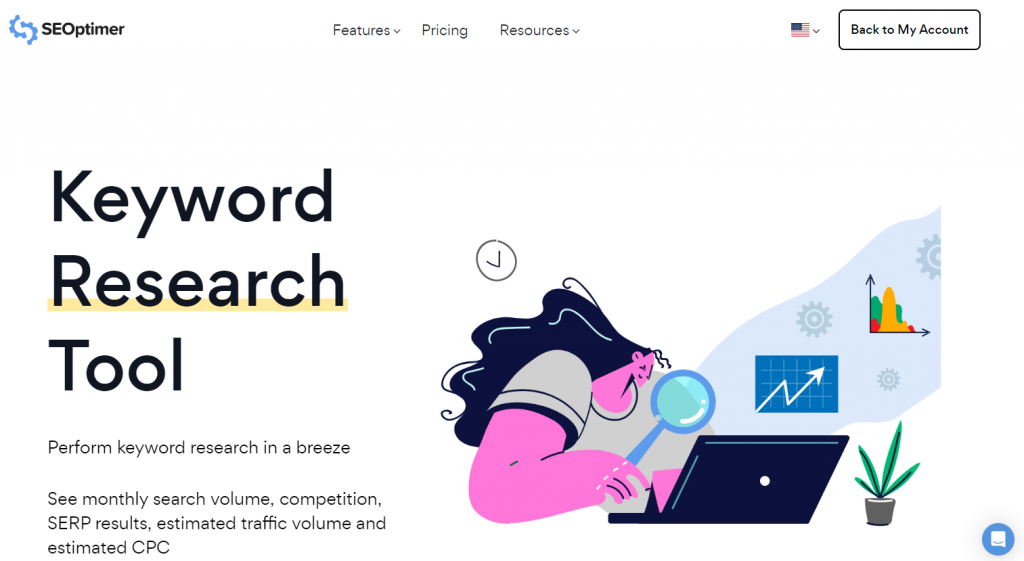
Content Outline
When some people hear the term content brief, they immediately think of a content outline.
While this isn’t the only component of a content brief, it’s still quite essential, and no content brief is complete without one.
The content outline contains the main headers and subheadings that you want the writer to discuss.
Some agencies prefer to give writers more autonomy than other agencies in the market. And as a result, won’t include a lengthy outline in the brief.
The level of detail that you include in content briefs will depend on the decision that you’ve made with your team beforehand.
However, all content outlines, irrespective of the level of autonomy, should have at least all the top-level headings such as the H2 and H3s you want to be covered in the content.
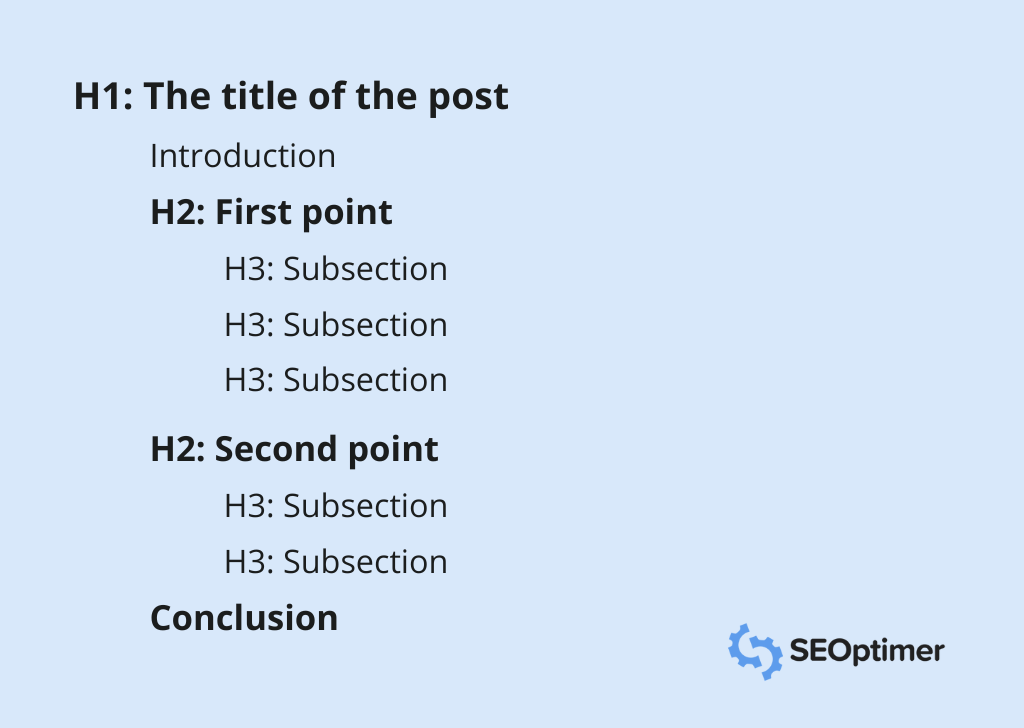
Competitors
Including the top 5 competing articles in the brief will also give writers some more background information on the topic and assist them in creating the content.
These competing articles give writers the “lay of the land” and provide them with the elements that need to be included in order for the content to rank.
Why Use a Content Brief?
There are several benefits of using content briefs for your writing.
Content Briefs Give Writers Clear Instructions
The first, and most significant, reason for using a content brief is to give your writers clear instructions on what they should write about.
Without a well-written, clear content brief, a writer may produce something that is the total opposite of what your or your client requires.
As an example, let’s imagine that you’ve got an HVAC business as a client, and they require a blog article about how to reduce energy strain during the summer months.
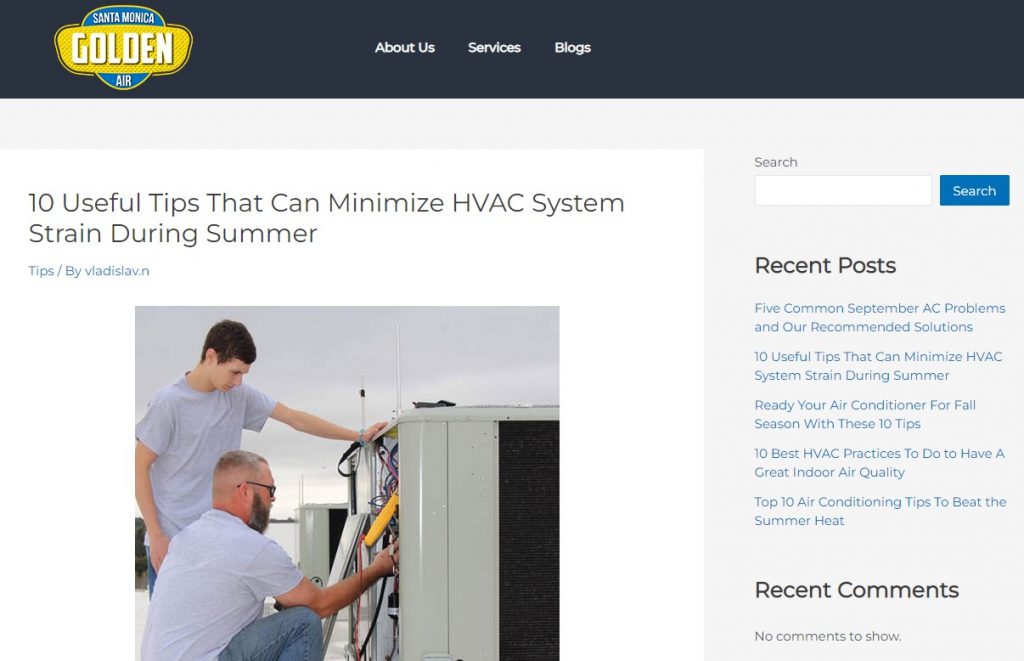
If you just tell your writer to produce an article on this topic without giving him a content brief, he may leave out any key discussion points.
Or the article he produces might just simply be too short in comparison to what already exists and is currently ranking in the SERPs.
A content brief will highlight any important talking points, definitions, and examples that the writer should focus on in the piece and any other nuances that should be taken into account.
Content Briefs Save Time
Agency owners and project leads tend to be under a lot of pressure and stress to complete projects and deliver great results.
They don’t have the time to go back and forth with a writer on what needs to be included and removed in a final draft.
Content briefs eliminate the need to do this. A proper content brief will give a writer everything he/she needs in order to create a final draft without having to ask for feedback along the way.
A well-written content brief will also reduce the time it takes for a writer to deliver a final article since it aims to reduce the need for rewrites and revisions.
Content Briefs are Essential When Growing an Agency
A team at a small agency won’t have the time or capacity to produce content especially if they’ve got multiple clients. As a result, they’ll need to probably outsource this activity to a writer or a team of writers.
By sending briefs to external writers, agencies can scale their content production operations, and potentially take on even more clients.
Furthermore, as an agency grows, the team members who were once in charge of writing content will get assigned new responsibilities, and will probably move into managerial roles.
For such an agency to continue producing high-quality content, they’ll need to create content briefs for their writers.
How Agencies Structure Their Content Briefs
Matt Diggity - Diggity Marketing

Matt at Diggity Marketing says that they view content briefs as blueprints - detailed plans vital for constructing solid, compelling content. They're not simply a set of instructions; they're a comprehensive vision of what the end product should look like.
“First things first, we begin with the 'why' - the goal of the content. Is it to educate, sell, or entertain? Knowing the purpose helps us zero in on the right audience and message.
Next, we're all about the SEO. We identify the key search terms we want to rank for, and sketch out a keyword strategy. This becomes our scaffolding, shaping the structure of the piece.
Then comes the audience analysis. Understanding who we're speaking to helps us fine-tune the tone, language, and examples we use. It's like selecting the right materials to match the aesthetics of our 'building'.
Finally, we provide a detailed outline with potential headings, subheadings, and bullet points. This forms the skeleton of the content, with key points and subtopics acting as the beams and supports.”
Michael Maximoff - Belkins
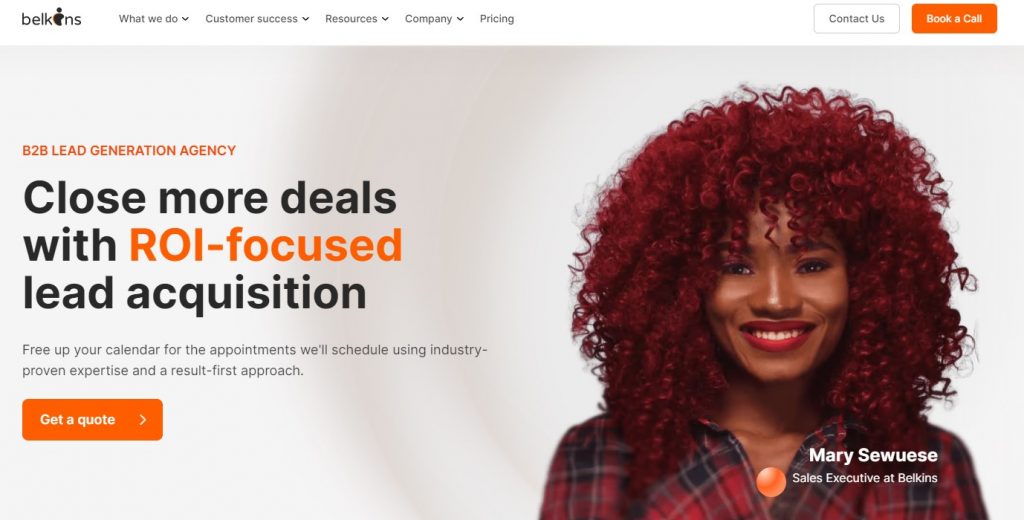
What’s unique about how this agency uses content briefs is how they give their writers a level of autonomy and flexibility to produce content.
“When it comes to structuring our content briefs here at Belkins, we like to keep things pretty simple by giving our writers just the basic pointers and letting them decide the rest. Giving writers more autonomy over content production and decisions has been working out well for us in the past few years, so we have pretty much stuck with it.”
Michael also points out that they’ve got different versions of content briefs dependent on the skill of the assigned writer. 
“We also have a different version of our content briefs for writers who are not as experienced or are working on special pieces that require a little bit more guidance and attention on our side.
In essence, our content briefs contain the basic information about the piece such as the title, word count, and outline, followed by a short description, some main keywords, an audience persona, and a short style guide.
All of these are just simple pointers that let our writers know what we are expecting, and the rest is up to them. In my experience, this approach works really well with experienced content teams that are in tune with the agency and its goals and processes, but extra detail is needed to brief less experienced writers and/or freelancers.”
Kevin Hall - Webserv

“At Webserv we strategically structure content briefs beginning with the Objective, explicitly outlining the goals.
Next what we include is the Target Audience, specifying whom we're addressing. Following this, we provide SEO-oriented Keywords and the Desired User Action, clarifying what we want readers to do post-reading.
The Structure and Format details offer guidance on the layout, while any necessary Research sources provide data backing. We cap it off with the Tone and Style guide to ensure the content aligns with the brand voice, encapsulating the overall brand message effectively.”
Milosz Krasinski - Chilli Fruit Web Consulting

Milosz and his team at Chilli Fruit have an interesting take on the content brief.
They like to imagine each content brief as a map.
Now, without a map, you can still wander and eventually reach somewhere, but with it, you’ll reach your destination faster, and likely in a more enjoyable way. That's the magic of a well-structured content brief.
“Our approach starts with outlining the purpose. What's the endgame? This is the "X marks the spot" on our metaphorical map. Is it SEO? Lead generation? Branding? Once we know where we're going, we get into the nitty-gritty details - keywords, target audience, and tone of voice.
The real fun begins when we sketch the journey. We provide a clear content outline, like a trail through a forest, guiding our writers through every twist and turn. This includes main points, sub-points, and even examples they can draw upon.
Lastly, we pepper in supporting details – data, references, sources – like signposts along the path to back up the narrative.
This blend of clarity and direction gives our writers the freedom to infuse their creativity while staying on the path to the treasure – our ultimate content goal. So, to my fellow explorers in the content creation world, remember: Don't start the journey without your map!”
Conclusion
As you’ve learned, content briefs as essential to the content production pipeline at agencies.
You’ve learned about the main elements that all content briefs should contain as well as how other agencies use content briefs in their content pipelines.
Feel free to use the content brief template that we’ve shared at the beginning of this article as a starting point for your content briefs.
